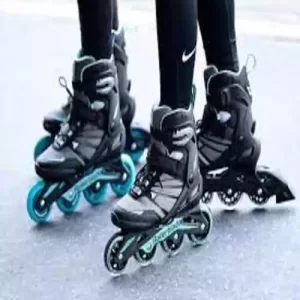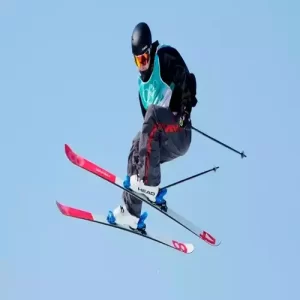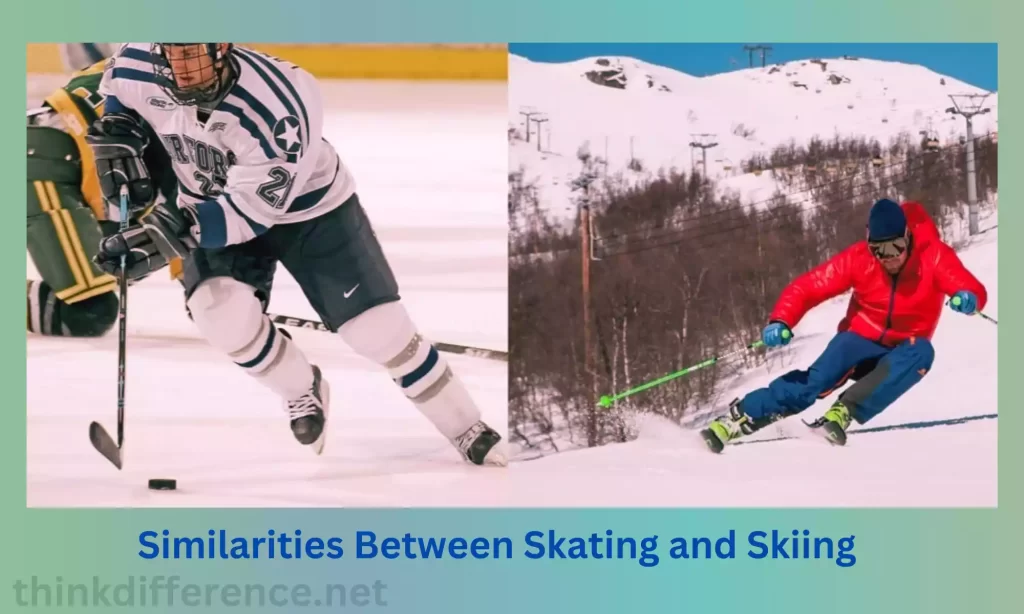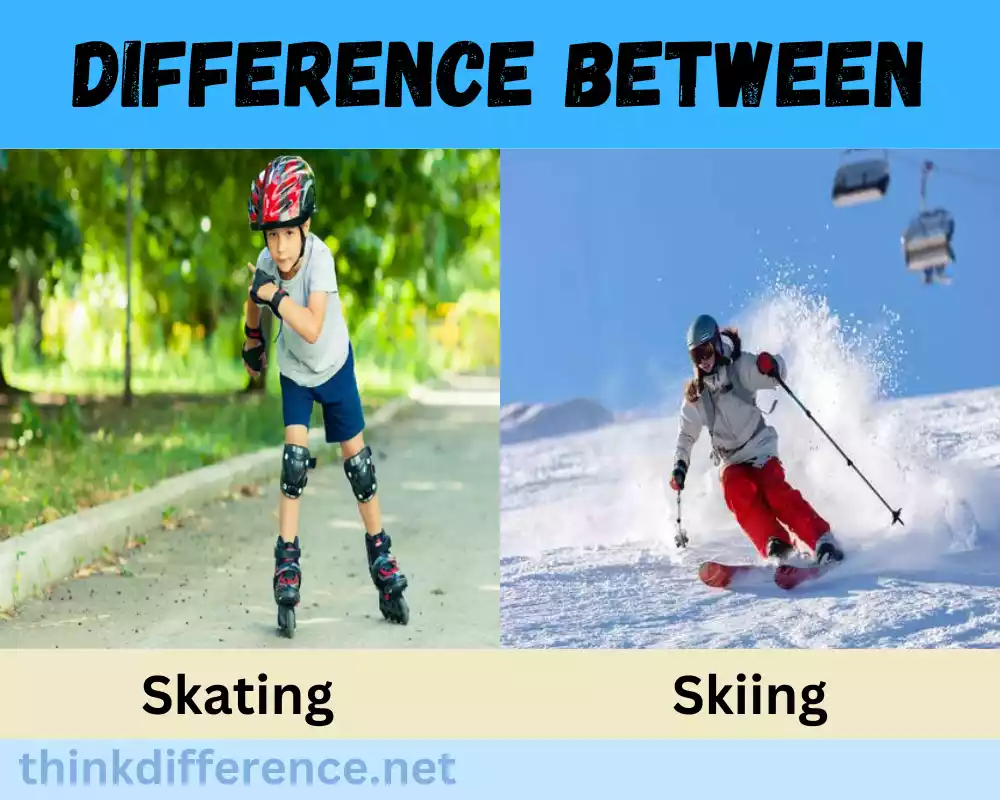Brief overview of Skating and Skiing
Skating and skiing are popular recreational and sporting activities that both involve sliding over surfaces. While both possess similar elements such as balance and coordination, there can be distinct differences when it comes to equipment, technique and surfaces used.
Skating involves moving along an uneven surface using specially-adapted footwear. Skating may take place both on ice with traditional ice skating techniques as well as on solid ground using roller skates or Inline skates; figure skating, speed skates, and roller derby are other forms of skating that involve turning and gliding; this sport emphasizes elegance, precision and artistic expression.
Skiing involves moving through snowy or groomed slopes on skis with poles attached directly to your feet, controlling speed and movement with techniques like parallel turns, carving turns, or mogul navigating. Skiing offers experiences ranging from racing to aerial stunts!
Skating and skiing differ due to requiring different surfaces; while skating takes place on hard surfaces or ice and requires skaters to glide along a single edge of their skates, skiing takes place on groomed slopes or snow where skiers balance on both edges simultaneously; skaters use special skates while skiers employ skis, poles, and boots to perform these sports effectively.
Skating and skiing both require balance and coordination their styles differ considerably, skating emphasizes grace, artistic expression, precision, choreographed jumps, and routines while skiing encompasses racing disciplines as well as freestyle tricks and backcountry exploration.
Skiing and skating offer distinct yet complementary experiences, making the choice easier when trying to determine what activity best meets your preferences, abilities, and environment. Both activities provide enjoyable yet fulfilling experiences as people glide across various surfaces with great joy.
Importance of understanding the differences between Skating and Skiing
Understanding the differences between skating and skiing is crucial for several reasons:
- Equipment Selection: Selecting the proper equipment becomes simpler when one understands the differences between skiing and skating. Skating requires special skates like roller skates or ice skates while skiing requires skis, boots, poles, and bindings – this knowledge ensures people have all of their required gear for safe performance in either sport.
- Skill Development: Skating and skiing both involve complex movements and techniques, and to develop and enjoy either activity successfully it’s essential to learn specific skills for both activities – understanding these differences will assist individuals in honing them for either activity and leading them towards greater proficiency and competence in either of them.
- Safety Measures: Skating, skiing, and other sports present unique risks that require specific precautions for their enjoyment and success. Knowing these distinctions helps people take appropriate precautions to reduce their chances of getting injured while skating on ice can cause slipperiness or falling while skiing is associated with speed, slope conditions, and collision risks; understanding safety issues allows individuals to take appropriate protective steps to guarantee their wellbeing as they follow guidelines set by official bodies and organizations.
- Select an Appropriate Environment: Skating and skiing activities take place across a range of surfaces – such as ice, hard surfaces, or groomed slopes – giving individuals plenty of choices in selecting an environment suitable for them and their chosen activity. Individuals have access to necessary infrastructure like skating rinks and resorts so that informed decisions about where best they wish to pursue skiing or skating can be made.
- Goal Setting and Enjoyment: An understanding of the differences between skiing and skating helps people set realistic expectations and manage their goals more successfully. Each sport offers its distinct challenges, styles, and disciplines; being aware of them allows individuals to set more attainable goals while focusing on aspects that resonate more with them; ultimately enhancing enjoyment in either activity.
- Community Involvement: Skating and skiing have active communities both locally and internationally. Understanding their differences enables individuals to engage with those communities by seeking guidance or participating in specific events, competitions, or group activities; doing so fosters feelings of belongingness while creating the opportunity for growth through encountering experts within each sport.
Understanding the differences between skiing and skating is vitally important when selecting equipment, developing skills, identifying a safe environment, setting goals, engaging communities, or engaging in any given community. Knowledge will allow individuals to make better decisions that enhance performance while increasing enjoyment during skating or skiing sessions.
Skating

Skating involves moving across surfaces using specialized footwear. Skating has long been considered both an enjoyable sport and recreational activity; different forms include ice and roller skating.
- Ice Skating: Ice skating involves moving along frozen bodies of water using sharp-bladed skates that allow users to glide effortlessly along its surface. Ice skating can be found both inside rinks as well as outdoors; popular disciplines for this activity include figure, speed skating, and hockey.
- Roller Skating: Roller skating, also known as four-wheeled skateboarding, involves traveling over solid ground using four-wheeled skates equipped with four wheels for turning and forward movement. Indoor roller rinks or outdoor settings both suitable environments to enjoy this activity – indoor rinks more commonly being preferred due to being enclosed for safety compared with outdoor settings; both recreationally as well as competitively; one such competitive form is roller derby; which provides fast-paced contact sports action!
- Inline Skating: Inline Skating or Rollerblading involves the use of inline skates designed with multiple rows in a line for use during inline skating or rollerblading, offering unique experiences of speed, agility, and maneuverability suited for skate parks, trails, or urban environments. Fitness enthusiasts, recreational skaters, or freestylers often perform tricks and stunts during this form of activity.
Balance, coordination, and fitness are necessary components of skating. Skaters learn techniques specific to their chosen form of skating such as gliding and turning turns while stopping short distances quickly or performing jumps and spins. Skating offers great ways to express artistically while exercising physically as well as socializing socially – enjoying it by people of all ages regardless of skill levels; beginners may be introduced to basic maneuvers while experienced skaters master complex ones with ease.
Equipment used for skating varies by type; inline skates include inline wheels while roller skates contain wheels and metal blades. Proper maintenance and care of skating equipment is crucial to maximize both its performance and longevity.
Skating provides many health and fitness advantages, from improving cardiovascular fitness and muscle strength, coordination, and balance to an incredible sense of achievement and fun! Skating provides the ideal way to express yourself creatively while connecting with like-minded individuals who share an interest in skating – it truly makes skating one of the best hobbies out there that anyone from any background can participate in and enjoy! Skating offers endless entertainment possibilities from solo skates up to competition-grade skaters of any age can enjoy it together!
Skiing

Skiing is both a recreational and competitive activity that involves sliding on snow-covered or groomed ski slopes with boots and poles, captivating people of all ages with various levels of skill. People of all ages enjoy this exhilarating outdoor activity!
- Alpine Skiing: Alpine skiing is one of the world’s most beloved forms of snowsport, consisting of skiing down snow-covered slopes at ski resorts with an emphasis on speed and technique. Skiers use carving and edging techniques to control their movements on this steep terrain. Alpine Skiing encompasses various disciplines like giant slaloms, slaloms, downhills, and super-Gs that all feature specific rules and course designs that skiers must comply with for successful participation.
- Cross Country: Skiing or Nordic skiing involves traveling long distances over flat or undulating terrain on skis shaped as skiers’ bodies using diagonal steps or skating movements, similar to Nordic skating. Cross-country skiing focuses on endurance, cardiovascular fitness, and strength and utilizes groomed tracks both within the backcountry as well as designated trails within urban environments for its practice.
- Freestyle Skiing: Freestyle skiing combines skiing with acrobatics and tricks such as aerials, slopestyle, moguls, and ski cross. Freestylers show their technical proficiency, creativity, and style by performing stunts and tricks at specially-designed courses or terrain parks.
Skiing requires a set of equipment tailored to the specific type of skiing:
- Skis: Skis are long and narrow devices equipped with curved tips and tails designed for gliding on snow surfaces. Their length and width may differ according to individual preference and skiing style, providing enough surface area to enable effortless forward progress on snow terrain.
- Boots: Ski boots are specifically engineered to be stiff and supportive, securely attaching to skis for energy transfer between skier and board. In turn, these boots transfer energy between the skier and the skis allowing greater control with each turn taken on snow. Each boot should fit comfortably according to an individual’s foot shape and type of skiing activity.
- Poles: Poles can help skiers with balance, timing, and propulsion. Adjustable ski poles include grips and straps to hold onto during use.
Skiing provides many health and well-being advantages, from improved cardiovascular health and coordination to experiencing winter’s stunning landscapes while testing themselves against its challenging slopes and terrain.
Skiing offers an active competitive scene with events like ski racing, freestyle competitions, and ski jumping attracting athletes worldwide. Resorts feature ski lifts and slope grooming facilities; in addition to ski schools for novice to expert level skiers.
Skiing is an enjoyable outdoor pastime that also combines athleticism and technique, providing ample opportunity for exploration during the winter season’s snow. Enjoy it and push yourself further than you ever have before!
Differences Between Skating and Skiing
The differences between skating and skiing can be categorized into several key aspects:
- Surface: Skating typically takes place on hard surfaces such as ice, asphalt roads, or roller rinks while skiing is done primarily on slopes covered in snow or groomed trails. Skaters glide smoothly over solid and sometimes slippery surfaces whereas skiers must negotiate resistance from snow that presents itself differently from solid surfaces.
- Equipment: Skating requires special footwear such as roller skates or inline skates designed specifically for skating on ice, roller skating, or inline skating, with various designs depending on whether it will be done indoors, outside, or inlines skating. Skiing requires skis with bindings attached for attaching boots while poles provide balance and propulsion to help a better experience.
- Balance and Movements: Skating and skiing both employ distinct balancing mechanisms that differ significantly: skaters will tend to balance on one edge of their skates for activities like gliding or turning; skiers use techniques such as parallel turns, carving turns, and maneuvering around moguls on both edges to balance themselves out on their skis.
- Techniques and Skills: Skiing and skating both require different techniques and skills. Skating requires balance, coordination, and precise movements while transitions, posture, and edging play an integral part. Skaters learn jumps, spins, and intricate footwork from coaches while skiers may acquire specialization in disciplines like racing, cross-country endurance, or freestyle tricks.
- Styles and Activities: Skating and skiing both offer unique styles and activities; skating emphasizes artistic expressivity, grace, and precision while activities like figure and speed skating showcase specific disciplines; skiing includes various alpine (downhill), freestyle, cross-country skiing as well as ski touring/backcountry exploration activities.
- Environments: Skating and skiing can both be enjoyed in various environments. Skating may take place indoors in ice rinks or outdoors on frozen water bodies such as lakes; and specially-designed roller skating rinks; whilst skiing takes place across snow-covered landscapes like ski resorts, trails, and backcountry areas that meet certain snow criteria.
Understanding the differences between skating and skiing activities is critical for anyone wanting to participate. Doing so enables individuals to make educated choices regarding appropriate equipment, the most efficient techniques to learn, the appropriate environments and styles, and disciplines that fit with their goals and interests – leading to more enjoyment out of both pursuits!
Understanding their respective differences enables people to approach both pursuits with an appropriate mentality – preparing themselves appropriately for whatever path their chosen pursuit might lead them down.
Similarities Between Skating and Skiing
Skating and skiing may differ significantly as sports disciplines, yet both share many similarities.

- Balance and Coordination: Balance and coordination are crucial aspects of both skating and skiing. Skaters must maintain balance while moving over their surfaces while skiers require good coordination to move smoothly through them. Both sports require good balance.
- Physical Fitness: Both skating and skiing provide great ways to increase overall fitness. Both activities engage multiple muscle groups in both legs and upper body resulting in stronger strength, endurance, and cardiovascular health benefits.
- Equipment Maintenance: Skating and skiing require special equipment that needs regular upkeep to function optimally, including blades, edges, and bindings. You should ensure this equipment remains free from wear and tear by sharpening blades regularly or adjusting bindings as required; additionally, you should inspect it for damage or wear periodically.
- Skill Progression: Skill progression in both skating and skiing is possible through practice and instruction, allowing beginners to hone their technique, balance, and control while developing simple movements to more advanced maneuvers – giving individuals a sense of achievement and growth along their journeys.
- Recreational and Competitive Aspects: Skating and skiing can be enjoyed both recreationally and competitively, whether on an open lake, race track, competitions, or training professional events. Skating on frozen bodies of water such as lakes is one way to enjoy these sports while skiing is also great fun as an activity when vacationing or for professional events training events can make an enjoyable pastime!
- Outdoor Fun: Skating or skiing offers you an engaging outdoor experience, often offering stunning landscapes – be it frozen lakes with city lights nearby, ice skating rinks with city lights behind them, snow-covered mountains – to enjoy. Both activities provide great ways to connect with nature.
- Social Engagement: Skating and skiing offer unique social engagement and community involvement opportunities, often connecting through groups or clubs where individuals share experiences and form lasting friendships through these sports. A shared love for these activities fosters an immediate sense of community with fellow enthusiasts – creating an instant sense of belonging!
Skating and skiing are enjoyable physical and social pursuits that provide endless physical rewards and challenges while connecting people through movement. Both activities give people an outlet to express their passion for movement while meeting like-minded peers along the way.
Conclusion
Skating and skiing are distinct sports with unique qualities; yet there are similarities. Anybody interested in either activity must gain an understanding of these distinctions to make informed decisions and develop the skills necessary for their chosen activity.
Skating and skiing provide great outdoor enjoyment while simultaneously engaging the community through social interaction and civic involvement. Skiers and skaters who share this interest can connect with fellow enthusiasts by joining clubs, competing or recreational events, or joining teams dedicated to these sports.
Skating and skiing are both physically enjoyable activities with social components that bring people together. No matter if it is done on snow or ice, both activities allow individuals to express their love of movement while pushing themselves further while creating memorable experiences that stand the test of time.

